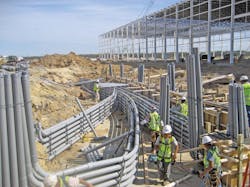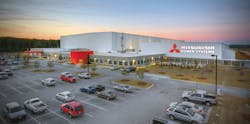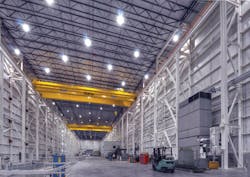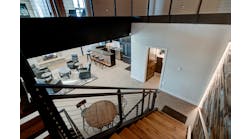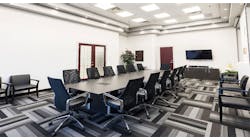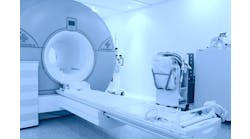A 110-acre tract of land neighboring Savannah, Ga., is now home to Mitsubishi Power Systems America’s (MPSA) first turbine manufacturing and repair facility outside of Japan. Named Savannah Machinery Works, this plant will assemble gas and steam turbines and generators used in power plants and hydroelectric dams.
Before the plant opened its doors, however, a construction team spent four years constructing the facility in multiple consecutive phases. A joint venture of H.J. High Construction Co. and Batson-Cook Co. relied on the services of Excel Electrical Technologies, Inc., the electrical contracting firm, Conway & Owen, the electrical engineer, and The Austin Company, the project design engineer, to complete this design-build project.
Constructing the manufacturing space
Phase I of the project consisted of a 50,000-sq-ft office facility and two bays of manufacturing plant space. Bays 1 and 2 totaled about 140,000 sq ft of space. The owner then added three more manufacturing bays, each measuring 80,000 sq ft. Finally, a separate building to be used for balance testing of the assembled turbine was incorporated into the project. Called the Balance Bunker, the structure is only one of 12 such buildings in the world.
Each of the manufacturing bays accommodates a different aspect of the manufacturing process for the electric generator turbines. For example, in Bay 1, workers begin the process of fabricating the turbine by making all the parts. Next, the parts move to Bays 2 and 3, where the turbine is then assembled. Once assembled, the 400-ton turbine is then loaded on a rail car and transported to the on-site Balance Bunker, where it is spun by a 4,000-hp motor, balanced, and adjusted before being moved into Bays 4 and 5, where it is prepared for shipment.
Excel Electrical Technologies was responsible for the electrical design and construction of Phase I of the project as well as Bays 3 and 4. The owner awarded Bay 5 and the Balance Bunker portion of the project to Excel in a more traditional arrangement, where the engineering portion of the project was completed by Conway & Owen and construction work by Excel.
Installing electrical equipment
Throughout the project, Excel’s team of electricians was tasked with installing specialized equipment throughout the manufacturing facility. For example, Bays 1 and 2 are served by three 4,000A, 480V services, and the electricians had to connect more than 100 pieces of specialized equipment fed from distribution panelboards located throughout the bays. These bays were illuminated with high-output, 6-lamp, high-bay fluorescent luminaires.
When working on Bays 3 and 4, each measuring 800 ft long, 105 ft wide, and 80 ft tall, Excel installed two more 4,000A, 480V service switchboards, a 2,500kVA transformer, and 800 ft of 4,000A bus duct located 60 ft above the finished floor. In addition, they routed power to two 150-ton bridge cranes, two 30-ton bridge cranes, and many metal lathes and milling machines.
Bay 5, lit by high output 10-lamp fluorescent high-bay luminaires, included a 4,160V service to two 4,000A, 480V switchboards serving numerous pieces of equipment, including two 60-ton bridge cranes and 15 30-ton gantry cranes.
Lowering power costs
While the owner furnished all of the equipment necessary to support the 3,300V, 4,000-hp turbine test drive system in the Balance Bunker, Excel was responsible for all coordination, installation, and connection of the equipment.
An unusual feature of this project occurs when each turbine test is complete. As the 4,000-hp motor coasts to a stop, the motor regeneration power is fed back onto the power distribution system and back into the building. This process allows Mitsubishi to recover some of the electrical utility costs required to operate the facility.
All of the oil lube mechanical pump equipment that requires a motor to operate in the Balance Bunker has an AC primary motor and a DC back up motor in the event of a power failure. The DC motors are designed as “run to fail.” As such, it would be less costly to replace the motors than it would be to replace a turbine if an oil pump failed.
Facing challenges on the job
When designing and installing the electrical equipment layout, Excel faced the challenge of staying ahead of the general contractor’s rapid construction progress. While the civil and structural design was nearing completion and the foundation and structural construction activities began, the owner’s requirements were constantly changing with respect to the equipment to be installed.
Excel based its design on a worst-case scenario for load demand. As such, the company sized distribution panels to allow flexibility of breakers and to include adequate spare capacity.
“Mitsubishi’s engineers were revising major pieces of equipment to incorporate the latest design for a state-of-the-art manufacturing process,” says Darren Lodge, project executive for Excel. “Many times, the changes of voltage and amperage for the equipment were only discovered once the equipment arrived on-site.”
With Excel’s flexible design of the electrical system, all of the necessary adjustments were completed on time, and all equipment functioned properly at the end of the project.
Another challenge for Excel was routing the feeds to more than 130 pieces of equipment. The feeds could not be run high overhead and dropped down, as it would interfere with the pathways used by the more than 30 cranes. Excel designed and installed a system of pipe trestles and basket cable trays to allow the multi-conductor power tray cable feeds to run on the bridges. This solution provided a safe work area and allowed the owner the flexibility to relocate equipment with minimal effort in the future.
One key to the contractor’s success on the project was Dale Hunter, Excel’s superintendent who has more than 30 years of experience. Hunter worked very closely with the construction team and with the owner’s representatives to help solve design and construction problems as they progressed through the various phases of the project. He was also responsible for keeping the workers focused on Excel’s commitment to safety.
The MPSA plant began construction in March 2009 and officially opened in June of 2013. Now MPSA has a plant in the United States to create, test, and ship turbines to fuel power plants throughout the world.
Fischbach is a freelance writer based in Overland Park, Kan. She can be reached at [email protected].

